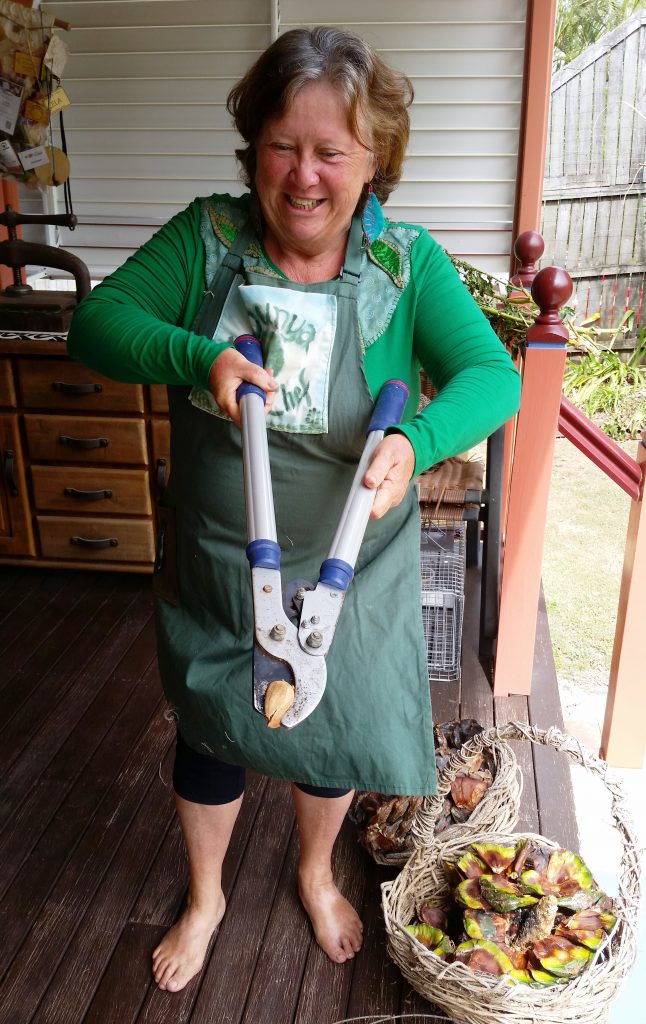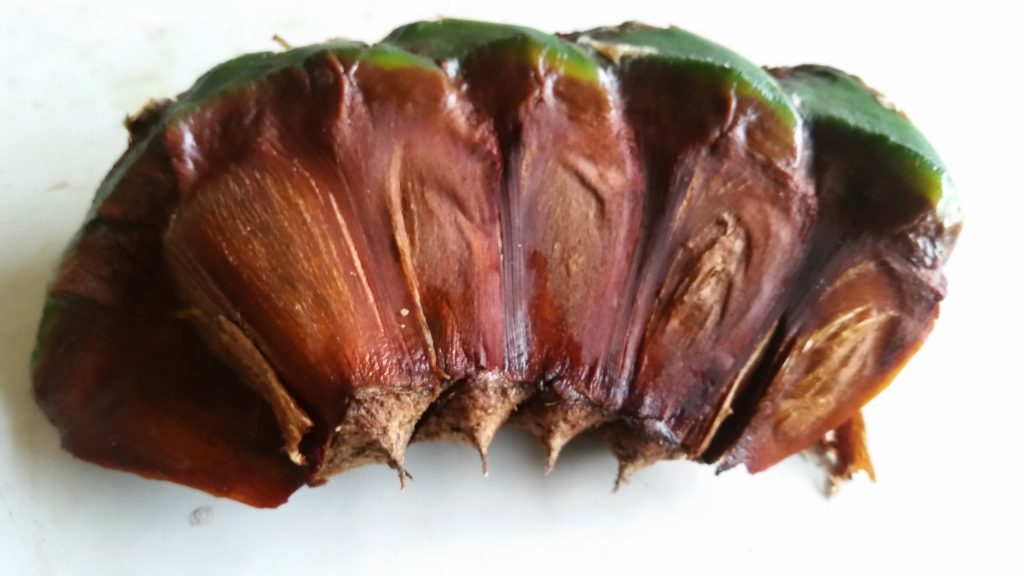A few anecdotes, some advice and a word we need to know.

?
Myth Number #1: Raw untreated Bunyas are poisonous
It was the year 2011. I entered the staffroom early and placed a large Bunya cone smack bang in the middle of the staff room table where all the teachers came to eat their morning teas and lunches. Then I stepped back to watch. The first group of teachers to come in commented immediately on the large green sphere on the lunch room table.
“What’s that?” asked the first voice.
“It’s a Bunya nut,” said a second voice.
“Can you eat them?” asked a third voice.
“Well, they’re very poisonous,” replied the second voice. “Aboriginals used to eat them but you have to put them in a dilly bag in a running stream for 3 weeks to remove the toxins.”
The office lady came in. “That’s funny,” she said. “I’m pretty sure my grandfather used to boil bunya nuts up with the corn meat and eat it like potatoes.”
Who is correct?
Well, let’s just say the office lady knew more than the teachers. I’ve told this anecdote to give a sense of the confusion that exists about eating native foods. Regular readers of Gympie Living will know that the Bunya kernel is in fact a very edible and nutritious food and is safe to eat straight from the cone. Around this time of year, they’re falling from the trees – literally. The biggest danger is from falling impacts, so be cautious when gathering!
Back in the day when this staffroom anecdote took place I was employed as a science consultant by the education department. My job was to encourage teachers and empower them in making Science exciting and relatable for students. The basic assumption is that for students to learn anything, the adults in their lives, their parents and teachers, must know correct facts to teach them. To be fair to this well-meaning group, it is not always easy to know the facts from the fiction. For instance, my friend in the staffroom was correct insofar as there are some native foods which certainly do require extensive preparation to get rid of toxic alkaloids. These include the fruits of the cycad (Macrozamia douglasii) and the Black Bean (Canastospurnum australe). I recommend that you leave those alone.
Later in my career I was creating tasting plates of our edible native plants for community festivals such as Relish Festival in Maryborough and the Gympie Garden Expo. When I arrived in Maryborough just a few years ago with my trays of native edibles, I was surprised when one of the organisers of the Relish event asked me, “What’s a Bunya nut? Is it just another name for a bauple nut?” Those like me who grew up in Maryborough will know that a “bauple nut” is the Butchulla name for what we now (mostly) call a macadamia nut. I had to tell her, “No a Bunya nut is a different genus, a different species and a completely different food group.” Then I pointed out a huge specimen of a bunya with a high domed crown and dark green prickly branches growing in the adjoining botanical gardens overlooking the Mary River. She looked at me doubtfully. “That’s a bunya tree?” she asked.
Myth #2 The Bunya is a nut
I fell back on my research skills and discovered that during the 1990s, Australia’s venerable science research outfit, the CSIRO, had set out to look at the nutritional value of some of our native foods. The bunya “nut” was one of them. Naming things a “nut” presents problems. The bauple nut (or macadamia) is a true nut. To be a nut, the food needs to have an oil (or lipid) content of 10% or more. Such nuts can have oil pressed from them which can be used for cooking. The Bunya kernel is mis-named as a nut: it does grow in a large cone on a very long-lived tree, however the oil content, as established by the CSIRO during the 1990s, is only 1 – 2 %. The research sampled nuts from various trees across South East Queensland and found that there was quite a significant variation in the nutritional content between kernels. Kernels from some cones had an average of between 10% and 20% protein but the most significant nutrient was complex carbohydrates. Most of the Bunya kernels sampled by the researchers contained between 40 to 60% complex carbohydrates. Add to this a good percentage of fibre and lots of trace elements and you have a very healthy food: in fact you have a food similar to most traditional cereal grains, minus the gluten. I share these anecdotes because knowing how to eat local free food is an important part of living sustainably on Country.
Myth Number #3: The Bunya Mountains National Park is the only historical gathering site.
Even many well-informed people are under the misapprehension that the area of the current Bunya Mountains National Park was “THE” Bunya Mountains to which all people travelled to feast in traditional times. In fact, South East Queensland was studded with Bunya groves and orchards. The location of the Bunya Gathering famously attended by the young Tom Petrie in his memoir was the stand near present-day Maleny, now inundated by the Baroon Pocket Dam. Various groups attended gatherings at many different locations during the Bunya Season. Many clans were invited to Bunya groves on Wakka Wakka lands (broadly the North and South Burnett regions) under time-honoured arrangements. Settler ignorance about this custom caused a tragedy that claimed many innocent lives. The historical record tells us that early settler John Mortimer complained to the colonial government in the late 1850s when a group of people gathered at a bunya grove near Manumbar were attacked by the Native Police. Mortimer gave sanctuary to survivors on his property, now owned by the Franz family, and it was his complaints about the slaughter of unarmed people that triggered the 1861 Inquiry into the conduct of the Native Police. Mortimer became an outcast among settlers for his championing of the Aboriginal people. The grove of trees was cut down in an act of deliberate cultural vandalism. I want to conclude with a story about a word that has entered into the present day as a place name, but few understand its significance: nangur. Back in 2011, I put a pack of shucked bunya kernels into a plastic bag in the fridge, and when I took them out nine months later, my Aboriginal friend, Eugene, became very excited and said, “Nangur! Nangur!” I looked and saw white shoots sprouting from the tapered end of the kernels. Eugene told me that Nangur Creek, which crosses the Burnett Highway twice on the way to Goomeri, was so named because, after visiting for the Bunya season, people from Butchulla Country would return to their traditional lands via that creek, and often buried kernels in the soft mud of the creek back to preserve them. Some of these kernels would sprout in the cool mud, creating a resource intended to feed the travelers of future years. My friend said they would not eat the kernels which were nangur, as they were given protected status because they were trying to grow. So next time you drive along the Bunya Highway, look out for Nangur Creek and remember this story.

0 comments on “BUNYA FACT AND FICTION”